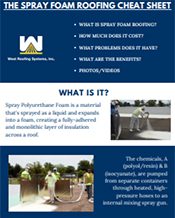Spray Foam Roofing
A continuous, monolithic membrane that adheres directly to the surface it is applied to, creating a seamless, watertight barrier.
For an average 20,000 sq. foot commercial roof, it will usually cost between $5 and $10 per square foot in materials and labor to install a typical spray foam roofing system. This price range is for a spray foam roof of average thickness and building structure.
Increased material costs, gas prices, and many other variables can push the cost of an installation past the $5-$10 threshold.
Here are common variables that affect pricing:
- The present amount of wet insulation
- Size of your roof
- The thickness of SPF (R-value desired)
- The current cost of materials
- How much of a slope your roof is on
- Access to your roof
- Length of warranty
This article describes all these cost variables in more detail.
Spray Polyurethane Foam For Commercial Flat Roofs
Spray Polyurethane Foam (SPF) is an eco-friendly roofing option for commercial, industrial and manufacturing facilities. While SPF roofing is not the most known type of roofing material, the technology has been around since the early 1960s for industrial, commercial, and residential facilities. An SPF roofing system can be used in any climate, and when properly installed and maintained, can last over 50 years.
Here at West Roofing Systems, we’ve been installing Spray Polyurethane Foam Roofs out of Cleveland, Ohio for over 40 years. Our turnkey solutions deliver energy savings, reduced maintenance, and sustainability – not to mention a durable, long lasting, quality roof.
West Roofing Systems’ experienced project managers and applicators bring decades of experience to each job, ensuring the best solution at the best price.
A spray polyurethane foam roof system decreases energy expenses, contributes to LEED and Energy Star certification, provides a heat, moisture and air barrier is easy to maintain and can last for years by renewing the roof’s protective coating. Building owners realize significant reductions in energy expenses for heating and cooling, as well as reduced maintenance costs.
The benefits of installing a spray polyurethane foam (SPF) roofing system, rather than another roof type, are numerous in terms of installation, performance, cost, and longevity.
Minimize Tear-off
One of the best ways to save money is to avoid the complete tear-off. In many cases, spray foam can be installed over an existing roof, saving the building owner money.
Energy Efficient
Spray foam has an R-value of 6.5 per inch of thickness. This is the best R-value per inch of any roofing insulation out there.
Durability
Seamless and Waterproof
Environmentally Friendly
Before the installation can start, the existing roof (or substrate) needs to be prepared. Rather than stripping the existing roof, the contractor will most likely prepare the substrate by getting rid of all dirt, dust, and contaminants. This can be done with air pressure, vacuuming, or even just sweeping.
The first layer put down by the contractor is the polyurethane foam. This foam is created by combining two liquids (a polyol/resin and an isocyanate) as it’s sprayed onto the existing roof substrate.
As the liquid is sprayed onto the existing roof, it creates a foam that expands 20 times in size to form a solid, seamless foam surface. When the foam has expanded, this layer can be between 1 and 1.5 inches in thickness. Since the polyurethane foam adheres to most common surfaces, it can be installed on any roof slope.










